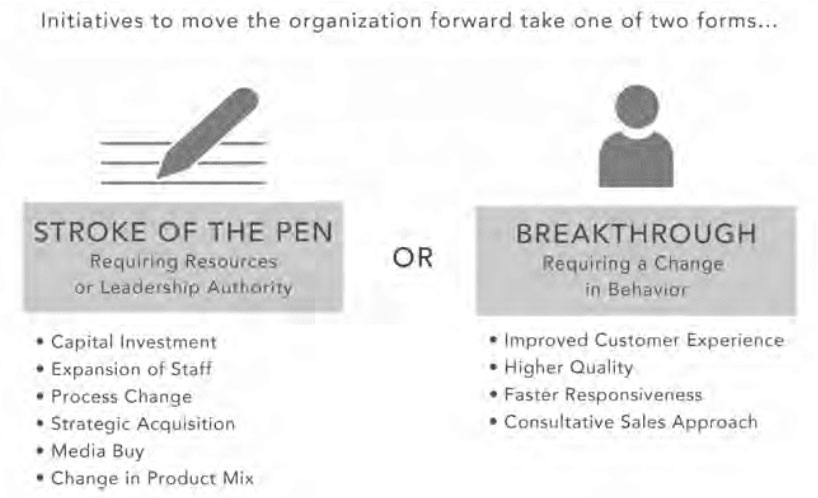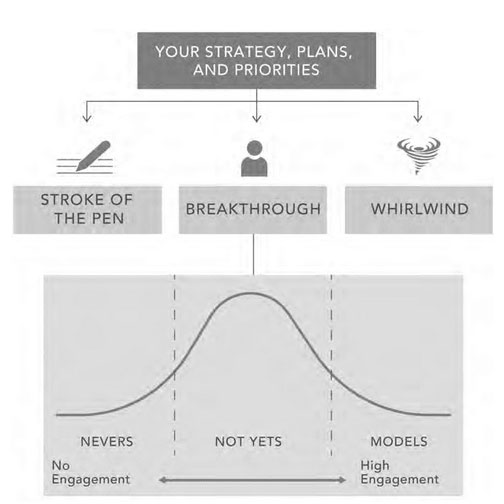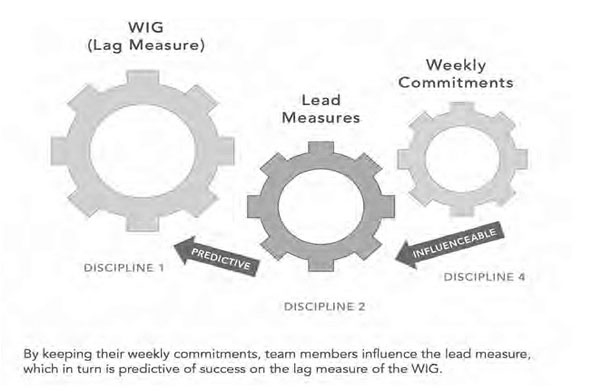The Real Problem with Execution

Whether you call it a strategy, a goal, or simply an effort at improvement, any initiative you as a leader drive in order to significantly move your team or organization forward will fall into one of two categories. The first mainly requires a stroke of the pen and is relatively straightforward to execute; the second is a breakthrough, requiring a change in behavior and will likely be the hardest challenge you’ve ever faced.
Stroke-of-the-pen initiatives are those you execute just by ordering or authorizing them to be done. If you have the money and the authority, you can make them happen. It might be a major capital investment, a change in the compensation system, a realignment of roles and responsibilities, an addition to staff, or a new advertising campaign. While executing these strategies may require planning, consensus, guts, brains, and money, you know that in the end, it is going to happen.
Breakthroughs that require a change in behavior are very different. You can’t just order them to happen, because executing them requires getting people—often a lot of people—to be highly engaged in a new or different approach to creating results. And if you’ve ever tried to get other people to change, you know how tough it is. Changing yourself is hard enough.
For example, have you ever tried to persuade a sales team to become more consultative in their approach to customers, or induce an engineering team to collaborate with the marketing team on product design, or convince a call-center team to embrace a new software platform? You can’t just send out an email to the sales team declaring: “Starting tomorrow, we would like everyone to be more consultative!”
In fact, you may be trying to change routines that have been entrenched for decades. Even when everyone recognizes that the old approach will never lead to a new level of performance, getting human beings to change is hard.
Stephen Covey once summarized this challenge as follows: “To achieve a goal you have never achieved before, you must start doing things you have never done before.”
Even though this may sound simple, if it requires people to do something different, you are driving a breakthrough strategy, and it’s not going to be easy.
One of the best ways to begin is to consider each individual on your team in terms of their willingness to change, to embrace something new. You can expect the people to fall into one of three categories.
The first category is comprised of those people who engage quickly. These are your early adopters—the ones who energetically embrace and model the new behaviors that will create improved results. These are also the members of your team who are most open to new ideas, who have a willingness to try new approaches, and who are generally the most committed to winning. We refer to these individuals as Models.
There is another category (usually a much larger percentage of the team) who may appear to be in full support of the breakthrough, but in reality, have embraced only a minimum of the changes required. They are doing just enough to appear supportive without ever really committing. We call these individuals Not Yets, because they have not yet fully engaged.
Finally, and unfortunately, a percentage of the team will never embrace the changes that breakthrough results require. We call this category the Nevers. Most often, the individuals in this category will never adopt, much less embrace, a significant change to the way they’ve become comfortable performing.
Models are found in both best-in-class organizations and those that are struggling. They create pockets of excellence, and are usually the source of outstanding results. Their high performance is valuable not only because it produces results, but also because it confirms that breakthrough results are possible on a larger scale. The greater your percentage of Models, the higher the performance of the team.
But pockets of excellence are also the bright side of a darker problem. Almost every organization also experiences significant variability in performance—highs and lows that are predominantly driven by the Not Yets and the Nevers. The greater your percentage of Not Yets and Nevers, the more inconsistent your results will be.
These two dynamics—pockets of excellence and variability of performance—exist in both the best- and worst-performing organizations. What actually separates the best and worst performers is the shape of their respective curves. The high performer’s adoption curve is more “right and tight.”
While leaders have to accept that they will always have an adoption curve, they do not have to accept the shape of that curve. Leaders who accept the shape of their adoption curve are, in a sense, giving up on improving execution and have limited themselves to improving results only through changing strategy.
The better approach is to accelerate your team’s ability to execute by implementing 4 powerful disciplines. We call these The 4 Disciplines of Execution.
Discipline 1: Focus on the Wildly Important
Discipline 1 requires that you identify the one objective that will be separated out and given intense focus. This difference is signified by the name Wildly Important Goal. Your WIG is an outcome so significant that it cannot be accomplished without the finest efforts of your team and by performance that is above their day-to-day level.
Your WIG also must have a clearly measurable result, as well as the date by which that result must be achieved. For example, a revenue-focused WIG might be: “Increase percentage of annual revenue from new products from 15 to 21 percent by December 31.” This From X to Y by When format recognizes where you are today, where you want to go, and when you plan to reach that goal. As deceptively simple as this formula may seem, many leaders often struggle to translate their strategic concepts into a single From X to Y by When finish line. But once they’ve done it, both they and the teams they lead have gained tremendous clarity.
Discipline 2: Act on the Lead Measures
The second discipline is to apply disproportionate energy to the few actions (or behaviors) that will have the greatest impact on achieving the Wildly Important Goal. We call these actions “lead measures” because they are the measurable drivers that actually lead to WIG achievement. Think of it this way: A lag measure shows you if you’ve achieved the goal. A lead measure tells you if you are likely to achieve the goal— meaning that the team is doing the things that are most critical to goal achievement.
When a lead measure is well chosen, it creates results that are greater than the effort invested to perform them. Lead measures enable a team to work smarter by concentrating their energy into the actions that yield the greatest return. A simple example would be that while you can’t control how often your car breaks down on the road (a lag measure), you can certainly control how often your car receives routine maintenance (a lead measure). And the more you act on the lead measure, the more likely you are to avoid that roadside breakdown.
Discipline 3: Keep a Compelling Scoreboard
Discipline 3 is based on the principle of engagement. Remember, people play differently when they are keeping score. Great teams know at every moment whether or not they are winning. They must know; otherwise, they don’t know what they have to do to win the game. A compelling scoreboard tells the team where they are and where they should be, information essential to team problem- solving and decision-making.
There are four questions to ask when determining if a scoreboard is likely to be compelling to the players:
- Is it simple?
- Can I see it easily?
- Does it show lead and lag measures?
- Can I tell at a glance if I’m winning?
Discipline 4: Create a Cadence of Accountability
The fourth discipline is based on the principle of accountability. In this discipline, you create a cadence of accountability—a regular and recurring cycle of accounting for past performance, as well as committing to move the score forward.
In a 4DX organization, accountability means being truly committed, not only to the achievement of the WIG but also to your teammates. Each week, every member of the team makes personal commitments to the entire team that will move the score forward. Following the meeting, they then follow through in a disciplined way. Keeping weekly commitments drives the lead measures, and the lead measures drive achievement of the WIG.
Instilling these 4 Disciplines is the most important outcome for leaders at every level. Although achieving your Wildly Important Goal will always be the most immediate and most visible target, the greater achievement is your ability to establish a culture of execution—one where WIGs can be achieved again and again.
I wish you great success.
Written by Jim Huling.
Bring the best of the CEOWORLD magazine's global journalism to audiences in the United States and around the world. - Add CEOWORLD magazine to your Google News feed.
Follow CEOWORLD magazine headlines on: Google News, LinkedIn, Twitter, and Facebook.
Copyright 2025 The CEOWORLD magazine. All rights reserved. This material (and any extract from it) must not be copied, redistributed or placed on any website, without CEOWORLD magazine' prior written consent. For media queries, please contact: info@ceoworld.biz














